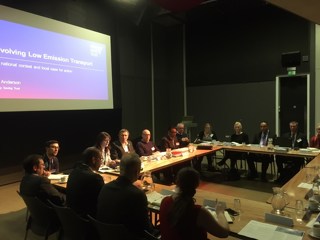The way transport is used in urban areas is changing, as cities across the UK take action to reduce vehicle emissions. Andrew Ryan reports.
Air quality: two words which are barely out of the news at the moment and words which will have a significant impact on how a fleet operates and what vehicles it procures in the future.
In recent years, the focus of environmental policies has largely been on reducing CO2 emissions, but, as carbon emissions contribute to the heating of the globe as a whole, the response has mainly been at national and international levels.
However, the focus has shifted towards improving local air quality and nitrogen oxide (NOx) emissions, in particular.
The impact of this pollutant is felt where the emissions occur, which means a local policy response is more appropriate in tackling the issue.
Here we look at why and how the Government and local authorities are tackling the issue.

Why are local authorities taking action?
The UK is exceeding the EU targets on safe levels of NOx and particulates in many places which means air quality is increasingly recognised as a serious public health issue.
It worsens people’s quality of life and increases the risk of respiratory and cardiovascular disease, stroke and dementia, reducing life expectancy.
The Royal College of Physicians and the Royal College of Paediatrics and Child Health estimate that 40,000 premature deaths a year are attributable to poor air quality.
They also estimate it caused more than six million sick days at a total social cost of £22.6 billion a year.
Children benefit from even a small reduction in air pollution. The findings suggest that efforts to tackle air pollution really can make a difference.
In 2007, levels of air pollution in the city of Stockholm fell between 5% and 15% after it introduced a congestion charge.
This reduction seems to have halved the number of children admitted to hospital with asthma attacks, from 18.7 kids per 10,000 to 8.7 per 10,000, according to a study by Emilia Simeonova, of Johns Hopkins University in Maryland.
The most immediate action required on poor air quality is tackling NO2 concentrations around roads, as it is the only statutory limit that the UK currently fails to meet.
The main cause of this is vehicles, with road transport responsible for 78% of NO2 roadside concentrations according to Ricardo Energy and Environment

What action is being taken?
Last July, the Government announced £225 million in funding as part of its Clean Air Strategy, and launched an additional £220m Clean Air Fund in the ensuing Budget, which authorities can bid for to support improvements in their areas.
There is a variety of approaches and mechanisms cities can use to improve air quality. These include reducing emissions by promoting public transport, cycling and walking, as well as accelerating the take-up of cleaner vehicles.
The Government has mandated 28 local authorities and the Greater London Authority to improve their air quality as they exceed legal limits of NO2.
Of these, 23 were required to create a plan to address a single, identified problem, while five – Birmingham, Derby, Leeds, Nottingham, and Southampton – are having to develop a clean air zone (CAZ).
All proposals have to consider the best options to achieve statutory NO2 limit values within the shortest possible time.
Draft plans had to be produced by March 2018 and final plans – requiring Government approval – by December.
Greater London will have an Ultra Low Emission Zone (like a CAZ) from April next year, with the five CAZs being implemented by 2020.
What are clean air zones?

A CAZ defines an area where targeted action is taken to improve air quality and resources are prioritised and co-ordinated to deliver improved health benefits and support economic growth.
The Government expects CAZs to facilitate low emission take-up, involve councils and contractors displaying leadership in vehicle procurement, improve local emission standards for taxis, buses and private hire vehicles, and support healthy active travel by cycle and walking.
Its Clean Air Strategy identified a CAZ where drivers were charged if their vehicles did not meet stipulated environmental standards as the most effective way of improving air quality in as short a time as possible.
However, given the potential financial impacts on individuals and businesses of a charging CAZ, the document said equally effective alternative measures which avoid these impacts would be ‘preferred’, and so local authorities were told to consider such alternative measures.
“Local authorities and city councils know the critical role fleet movement and transport plays in the local communities but they have been handed a bit of a political time bomb in terms of the impact this is having on lives,” says Andrew Benfield (above), group director of transport at the Energy Saving Trust.
“They have got to think about issues like displacement: if they put a CAZ in, what happens to vehicles? Can they just go round it, so are they shifting vehicles round to somewhere?
“Just the issue of drawing a line around the area is a charged one.”
The five areas which need to implement CAZs in 2020 are taking differing approaches (see table right) to which vehicles will be impacted by the CAZs.
London’s Ultra Low Emission Zone (ULEZ) will operate 24 hours a day, seven days a week within the same area as the current congestion charge zone.
The ULEZ standards are in addition to the congestion charge and the low emission zone requirements. The required ULEZ standards match those of the CAZs.
Benfield adds: “What is really key from a fleet perspective is that they need to know and get clarity on what is happening, when it is going to happen, and where the clean air zones are going to be, how long they are going to be in place for and when do they start.”
How does congestion charging work?
London has long been leading the charge to mitigate the negative effects of traffic in a city. It introduced its Congestion Charge in 2003.
This currently sees qualifying vehicles charged £11.50 to enter the congestion charge zone between 7am and 6pm, Monday to Friday.
Cars or vans (not exceeding 3.5 tonnes gross vehicle weight) which emit 75g/km or less of CO2 and meet the Euro 5 standard for air quality are exempt from paying the charge.
In 2013, transport officials announced that the scheme had resulted in a 10% reduction in traffic levels in its first decade. However, congestion charges alone do not necessarily reduce air pollution.
According to research presented in March at a meeting of the Royal Economic Society, the levels of three traditional pollutants – carbon monoxide (CO), particulate matter (PM10) and nitrous oxide (NO) – all fell in the four years following the introduction of the charge, with reductions as large as 25% to 30% for PM10 and NO.
However, the study found a sharp increase of between 10% and 20% in NO2 emissions in the same period. The authors argue that this increase is likely to reflect the shift towards diesel-based transport.
In October last year, London added the T-Charge (Toxicity Charge) to its congestion charge and this places an emission surcharge of £10 for the most polluting vehicles entering central London with the aim of phasing out older Euro 4 vehicles.

Transport for London, which runs the charging scheme, estimates that 40% of drivers subject to the emission surcharge will upgrade their vehicle and 7% will stop travelling into the zone.
“Introducing a congestion charge, modelled on London’s, should be a consideration for the most congested cities,” says Adeline Bailly, researcher at urban area think-tank Centre for Cities.
“Not only would such a charge help to cut down car use, it could also generate revenue to improve public transport, especially in less well connected parts of cities.”
London and Durham are the only places in the UK which operate congestion charging zones, although other cities, such as Bristol and Bath, are considering similar initiatives.
Plans launched by Bath and North Somerset Council earlier this month suggest a charge for high-emission vehicles driving into the centre.
Two of the suggested charging schemes would affect only coaches, buses, HGVs and taxis, while a third would also affect private cars with older engines which do not meet certain emissions standards.
Bob Goodman, cabinet member for development and neighbourhoods at Bath and North Somerset Council, says: “It may be possible for us to achieve the required air quality improvements without the need to charge cars, however, further detailed work has to be done before a final package is agreed later this year.”
How have Metro mayoral elections had an impact?
As well as legislation from the Government, politics at a more local level has also led to areas investigating the introduction of clean air initiatives.
Last year’s elections for mayors for the West Midlands, Liverpool city region, Greater Manchester, the West Midlands, Sheffield and Cambridgeshire and Peterborough, also saw air quality improvement on the agenda.
Of the six combined authority areas who voted in May, only Cambridgeshire and Peterborough is not considering introducing a CAZ.
There are no plans to implement an outright ban on HGVs and diesel vehicles across the six authorities, or to introduce congestion charges.
Last month Greater Manchester mayor Andy Burnham said the region could look to restrict certain vehicles from operating in polluted parts of the city region.
Speaking at the LowCVP Moving North conference in Manchester, Burnham outlined work to promote low emission vehicles within Manchester, including a network of plug-in vehicle charging points across the city.
“Could we begin to restrict the movement of certain vehicles in the areas where the air quality is unacceptably poor and damaging people’s health? I certainly feel we should. Maybe starting with the most polluting HGVs, but then perhaps moving to other vehicles,” he said.
He added he would not like to “punish” consumers who had bought diesel cars “in good faith” – and called for incentives from Government to move people towards cleaner vehicles.
Liverpool mayor Joe Anderson has asked for a report to be drawn up to detail a series of measures to tackle air pollution, including a low emissions zone targeted at diesel and large vehicles.
“By 2025, I want the city to have developed a central heart where walking, cycling, electric vehicles and clean fuels will dominate, and from which polluting diesel traffic will be discouraged,” he says.
“It will also be important to introduce these changes in order to stop older, dirtier vehicles that have been banned in other cities from being relocated to Liverpool.”

How does a workplace parking levy work?
Nottingham became the first city in the Northern hemisphere to introduce a workplace parking levy (WPL) in 2011, but could soon be joined by other UK areas: both Cambridge and Oxford are in the process of launching their own schemes.
Under Government regulations, the charge is levied on employers with 11 or more parking spaces and they can choose to either pay it themselves or pass it down to employees.
By law, any revenue has to be spent on improving transport to increase options for commuters.
Nottingham started its WPL scheme in 2012 and now charges £387 per parking space – equivalent to £1.50 per working day. It has raised more than £44m in the first five years.
“The levy contributes towards two of the three top transport objectives of the Nottingham business community – the expansion of Nottingham’s successful tram system and the redevelopment and capacity enhancement of Nottingham Station – along with investment in Locallink bus services connecting communities with key destinations, increasingly with electric buses,” says David Bishop, corporate director for development and growth at Nottingham City Council.
“More to the point, the schemes wouldn’t have happened without the levy.”
About half of all spaces are paid for by employees of businesses in Nottingham, while the city has among the highest public transport use in the country, with an associated fall of 40 million car miles over the past 15 years.
Mobility technology
As well as the advances in technology which is making cars, buses and freight vehicles more environmentally-friendly, technology is also impacting on other transport methods.
Public transport is moving from paper tickets to smart media (including smart cards, bank cards, watches and smart devices), while Mobility as a Service (MaaS) options are opening up whereby travellers can buy packages of mobility which could include the full range of travel modes.
Better information and payment mechanisms for travel can help people make better journeys, automatically obtain the best fare and avoid congested times and places.
The availability of data, and the ability to rapidly process that data, means transport planners are now better able to analyse and present the implications of choices that can be made about transport systems and schemes.
There is also the potential of open data to stimulate new products and services for travellers, helping to make joined-up travel information easy to access.
A smartphone app could provide information about all the options for making a journey as well as facilitate payment to make those journeys, be it by public transport, car hire, bike hire, ride share or taxis.





















Login to comment
Comments
No comments have been made yet.